PC Club Enpower ENP660: Back to School
by Jarred Walton on August 14, 2007 7:00 AM EST- Posted in
- Laptops
Synthetic Graphics and Gaming Performance
We don't place a lot of stock in the performance results generated by Futuremark's 3DMark applications, and the PC Club ENP660 isn't designed with gaming performance in mind. The Intel GMA X3100 GPU does run Aero Glass without any noticeable problems and it scores a 3.5 on the Windows Experience Index. SM3.0 is technically supported, but the performance of most games or graphics benchmarks leaves a lot to be desired. Intel is still working on getting fully functional drivers out, but they do have a public beta available that now allows a few DirectX 9 games to actually run on the GMA X3100. As a rough estimate of gaming performance, we'll start with 3DMark results follow with a brief discussion of our actual gaming experiences.
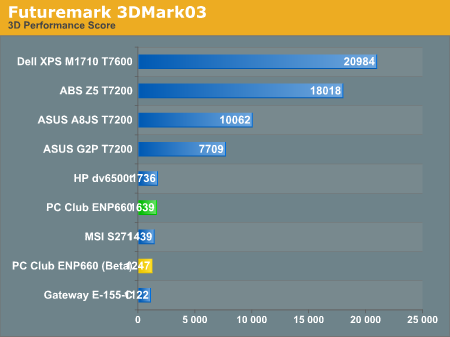
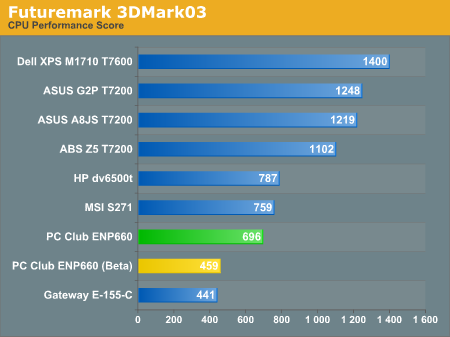
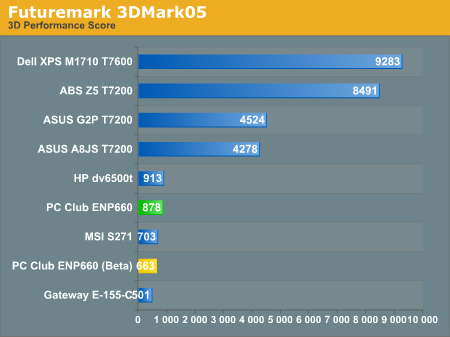
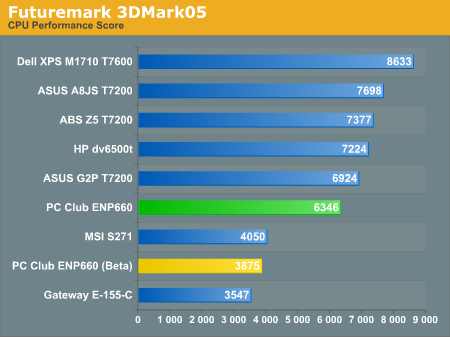
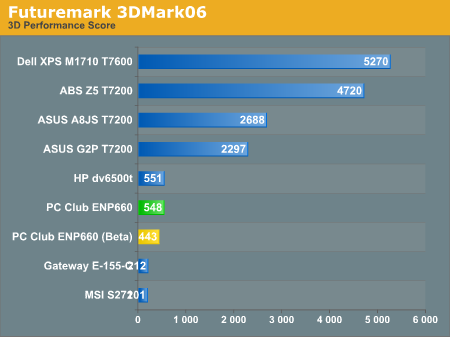
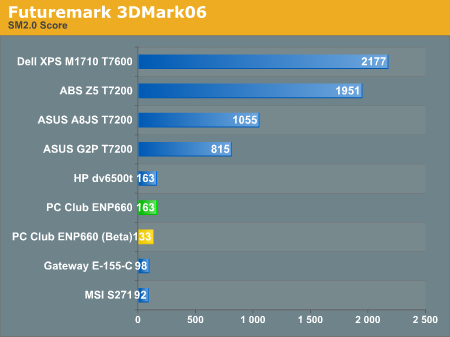
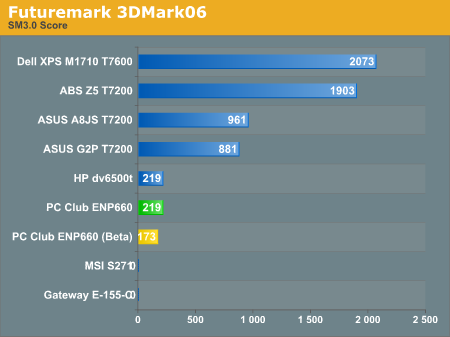
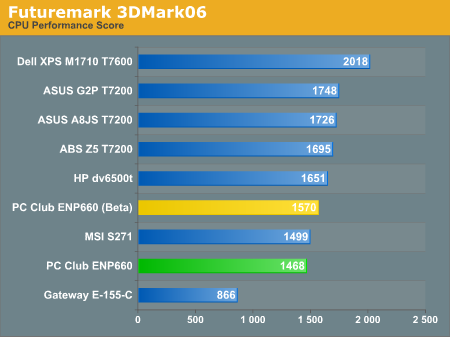
It's pretty interesting that the ENP660 with the latest Intel drivers loses in every 3DMark graphics benchmark to the older drivers on the HP dv6500t. Perhaps more telling is that the beta drivers actually make 3DMark performance drop even further! Last we checked, however, people don't "play" 3DMark; they play actual games. Did the latest beta driver from Intel help out with gaming performance?
Considering its beta status, we weren't too surprised that the results were hit and miss. Most games didn't run any faster, a few had performance drop, but there is a bright side to all this. There were a couple games that we couldn't load previously that would now actually load using the beta driver. (Note that the latest official driver (15.4.4) was released a couple weeks after the beta (15.6b) but does not include all of the beta features at present.) The beta specifically lists the following titles as being supported: Battlefield 2, Battlefield 2142, Call of Duty 2, Elder Scrolls IV: Oblivion, Vanguard: The Saga of Heroes, Rainbow Six: Vegas, Age of Empires 3, Final Fantasy XI Bench 3, and Unreal Tournament 2004. We did not test all of the titles, but we did confirm that Battlefield 2, Oblivion, and Age of Empires 3 could all run with the new driver. We still had to use more or less minimum quality settings in those three games along with lower resolutions, and there were still graphical artifacts. Frame rates generally hovered around 20 FPS. However, at least there is progress being made.
Before you get your hopes up too far, though, consider the theoretical level of performance on tap with the GMA X3100. The graphics core runs at somewhere around 400 MHz, with a maximum of two pixels processed per clock cycle. That means fill rate is at best ~800 megapixels. Memory bandwidth is shared with the system, and at maximum it gets 10.6GB/s (but more likely about half of that). The net result is that you have something which at best might perform as fast as a GeForce 3 - albeit with DirectX 9 features. Or if you prefer other terms, performance is relatively close to what you might get from the GeForce 6100. It's fast enough for office work, watching movies, and older/less demanding games. Sounds perfect for parents looking to get their college-bound student a new laptop! (We certainly wouldn't want them to play a part in helping their child fail classes because they're at home playing Team Fortress Classic....)
We don't place a lot of stock in the performance results generated by Futuremark's 3DMark applications, and the PC Club ENP660 isn't designed with gaming performance in mind. The Intel GMA X3100 GPU does run Aero Glass without any noticeable problems and it scores a 3.5 on the Windows Experience Index. SM3.0 is technically supported, but the performance of most games or graphics benchmarks leaves a lot to be desired. Intel is still working on getting fully functional drivers out, but they do have a public beta available that now allows a few DirectX 9 games to actually run on the GMA X3100. As a rough estimate of gaming performance, we'll start with 3DMark results follow with a brief discussion of our actual gaming experiences.








It's pretty interesting that the ENP660 with the latest Intel drivers loses in every 3DMark graphics benchmark to the older drivers on the HP dv6500t. Perhaps more telling is that the beta drivers actually make 3DMark performance drop even further! Last we checked, however, people don't "play" 3DMark; they play actual games. Did the latest beta driver from Intel help out with gaming performance?
Considering its beta status, we weren't too surprised that the results were hit and miss. Most games didn't run any faster, a few had performance drop, but there is a bright side to all this. There were a couple games that we couldn't load previously that would now actually load using the beta driver. (Note that the latest official driver (15.4.4) was released a couple weeks after the beta (15.6b) but does not include all of the beta features at present.) The beta specifically lists the following titles as being supported: Battlefield 2, Battlefield 2142, Call of Duty 2, Elder Scrolls IV: Oblivion, Vanguard: The Saga of Heroes, Rainbow Six: Vegas, Age of Empires 3, Final Fantasy XI Bench 3, and Unreal Tournament 2004. We did not test all of the titles, but we did confirm that Battlefield 2, Oblivion, and Age of Empires 3 could all run with the new driver. We still had to use more or less minimum quality settings in those three games along with lower resolutions, and there were still graphical artifacts. Frame rates generally hovered around 20 FPS. However, at least there is progress being made.
Before you get your hopes up too far, though, consider the theoretical level of performance on tap with the GMA X3100. The graphics core runs at somewhere around 400 MHz, with a maximum of two pixels processed per clock cycle. That means fill rate is at best ~800 megapixels. Memory bandwidth is shared with the system, and at maximum it gets 10.6GB/s (but more likely about half of that). The net result is that you have something which at best might perform as fast as a GeForce 3 - albeit with DirectX 9 features. Or if you prefer other terms, performance is relatively close to what you might get from the GeForce 6100. It's fast enough for office work, watching movies, and older/less demanding games. Sounds perfect for parents looking to get their college-bound student a new laptop! (We certainly wouldn't want them to play a part in helping their child fail classes because they're at home playing Team Fortress Classic....)










11 Comments
View All Comments
Kayaker123456 - Friday, December 28, 2007 - link
Be careful of buying anything from PC club. I took a computer and brand new case in for work and both cases were damaged. They stripped the alumium screws out on my Lian Li case and screwed in steel ones that stripped the holes. The black piano mirror finish on the Antec Solo case was scratched. Spoke to corporate and was told that they are not responsible. The have a poor rating by the BBB as they do not respond to complaints.Dadoftwo - Wednesday, August 15, 2007 - link
In your opinion, what is the best notebook/laptop money can buy, under $1000? Primary purpose would be for my daughter, a soon-to-be freshman in college majoring in accounting.JarredWalton - Thursday, August 16, 2007 - link
Look at some of the Turion X2 offerings. HP has some that come in at under $1000 with quite a few upgrades. The V6000Z for example - get a 1.8GHz CPU, 2GB RAM, and Office Basic 2007 for right around $1000. Dell's Inspiron 1521 is also pretty decent, and you can get a better LCD (say 1440x900 or 1680x1050) with 2GB and spend right around $1000. Basically, laptops don't tend to give companies a lot of ways to differentiate on the low end. Most $1000 or under laptops will end up being relatively similar - you can add memory and get a smaller HDD, or get a nicer LCD but have less RAM, or some other tradeoff.daytex5 - Wednesday, August 15, 2007 - link
Did the reviewer actually TYPE on the keyboard? After purchasing the the ENP660, I was initially impressed with the board's solid feel, but was quickly frustrated that such a broad case would include a compressed keyboard. Many of the right side keys (Backspace, Enter, period, etc.) are half-size or smaller. Even worse, the right-side Shift key is the size of a standard letter key making it difficult to hit. Whoever made the decision to include the ten-key numeric keypad was not keeping the target audience in mind.
JarredWalton - Thursday, August 16, 2007 - link
I used it quite a bit. It's a personal preference, obviously. The point is, outside of the keyboard there's really nothing else that separates this laptop from other laptops with a similar price and features - except for example the dv6500t is actually $125 cheaper. I like the numeric keypad, and I tend to use the left shift when typing. I was never bothered by the slightly smaller key size or the off-center location of the keys. However, I am sure plenty of people would feel differently.IntelUser2000 - Tuesday, August 14, 2007 - link
It says on Page 13: "At times we even see the CPU exceed its normal 1.80GHz clock speed, and likewise the memory runs a little faster than DDR2-667. However, this only occurs for short periods of time and the system stability was never compromised by the changing frequencies."If you paid attention to the Santa Rosa platform, you'll definitely notice that the increased speed isn't the side effect, but a new feature. Santa Rosa platform has Enhanced Dynamic Acceleration Technology, which allows core speed to go up to one bin when one of the two cores are inactive.
I didn't know it also changed the FSB frequencies though.
JarredWalton - Wednesday, August 15, 2007 - link
The thing is, these are very short changes (like less than .5 seconds), and they occur when the system is only moderately loaded - like playing a WMV9 encoded movie in this case. It could be overclocking for Santa Rosa, but it's not even 1 bin. It's overclocking because the FSB is running at 350 MHz instead of 333 MHz for a brief moment. I realize Santa Rosa allows OC'ing of one bin, but for that I would expect a one bin increase.strikeback03 - Tuesday, August 14, 2007 - link
Have you tested ASTRA32 on any other laptops which definitely have a newer/better panel? Unless HP uses the same OEM as the MSI barebones system, it would seem odd that there is that large a stock of old AU Optronics LCD panels laying around.JarredWalton - Tuesday, August 14, 2007 - link
The most recent LCD manufacturing date that I've seen on a laptop came with the Gateway E-155-C (Jan 2006). However, I wouldn't be surprised if AU Optronics had a bunch of old inventory that they clearanced, which could then be used in laptops to keep prices down.Astra32 reports March 2006 on a Dell 3000WFP and December 2006 on an HP LP3065. It definitely does report more recent dates, then, but is it truly accurate? It might be wrong, but AUO does make a lot of LCDs, and the performance of the MSI/PC Club LCD leaves a lot to be desired. I find it hard to imagine that a more recent LCD would have a black level of nearly 1.0 nits.
AUO also has a list of panels they produce, http://www.auo.com/auoDEV/products.php?sec=noteboo...">found here. The panels used in both the HP and MSI notebooks (and a couple other notebooks) don't show up in that list, though later version are there. At the very least, I thinks it's safe to say that the LCD used is an older model. 30 months old? Maybe not, but then why continue to use a 1280x800 panel on a new laptop if not for price reasons?
madonna grey - Wednesday, October 21, 2020 - link
I have been looking for this information for a long time. By the way, recommend a laptop that will be very convenient for studying.